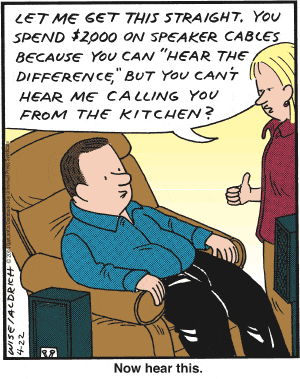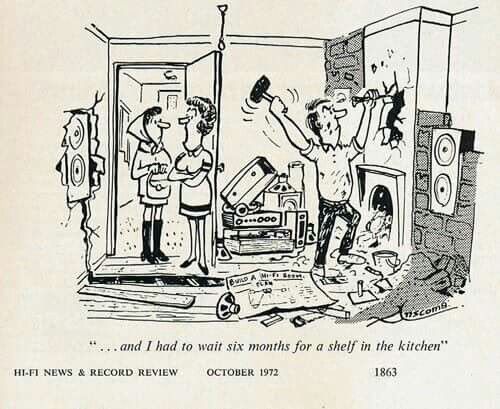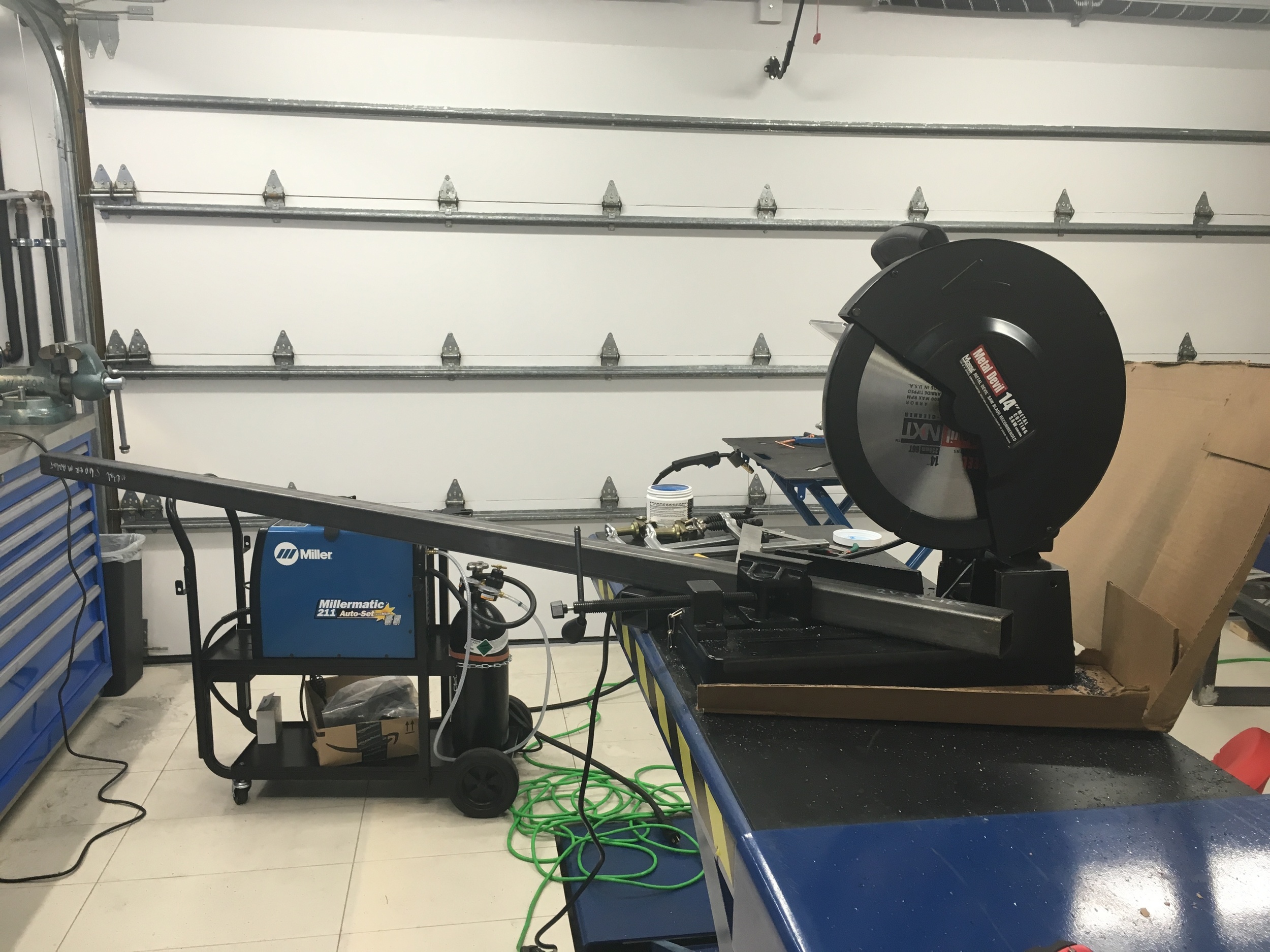Audio/Video
The Speakeasy
When we were looking for houses we found that many in the neighborhood were built during Prohibition and as such had speakeasy-themed rooms in the basement. Our house was built in the late 1920s and it had a beautiful 800 square foot solid mahogany speakeasy with a built in bamboo Tiki bar. There was also a small room with a movie projector that projected through a small hidden panel, built in storage for hundreds of film reels and a secret passage that went all of the way around the room – I’m no longer thin enough to use it though.
“Wife Acceptance Factor (WAF), are design elements that increase the likelihood a wife will approve the purchase of expensive consumer electronics products such as high-fidelity loudspeakers, home theater systems and personal computers. Stylish, compact forms and appealing colors are commonly considered WAF. The term is a tongue-in-cheek play on electronics jargon such as “form factor” and “power factor” and derives from the gender stereotype that men are predisposed to appreciate gadgetry and performance criteria whereas women must be wooed by visual and aesthetic factors.”
WAF and HAF
After seeing the speakeasy and garage, I was sold! No need to see the upper floors. The garage was on the same level and I envisioned a man cave for automotive and audio/video activities which would not be subject to any form of Wife Acceptance Factor (WAF). Now some may think that the WAF concept is archaic, sexist or even misogynistic. However my wife and I, as well as every couple that I know except one, fits those gender stereotypes when it comes to AV gear. That’s not to say that my wife doesn’t appreciate great sound – she does. She just doesn’t like the form factor. Let’s face it most audiophile equipment is large and ugly not to mention expensive. These different points of view are similar to our view of pillows – I truly appreciate a good pillow to sleep on, but I don’t see why we need over a dozen decorative pillows on the bed!
So why doesn't anyone talk about HAF? There a simple but painful truth— the ‘W’ has veto power and the ‘H’ (husband; that's me) doesn’t.
Objective
The room is a multi-purpose game room not a dedicated listening room or home theater. As such my objective was to achieve audiophile sound from a single audio/video system at a 'reasonable' expense. When it comes to audio, reasonable is a very relative term and I tried to avoid the allure of the 'placebo effect' – if it costs more, it must sound better. While all of the components are audiophile grade there are no $50k speaker wires or anything made of unobtanium. Fortunately the room has excellent acoustics and I wasn't even tempted to utilize any sound treatments that would wreck the mahogany walls.
WAF/HAF component Stand
I spent a lot of time looking for an audiophile audio stand. The high-end ones cost as much as a nice BMW and worst yet, many have white papers making claims that are orthogonal to others. No way was I going to find something that met both WAF and HAF criteria. So, I decided to build my own... how hard can that be? And, since I was doing it myself, it would be cheaper right?
In addition to the above table, I also designed a 60" x 18" base that sits directly on it's 2" x 2" frame (i.e., no legs). The idea was to isolate those components from the vibrations created by the center channel speaker siting on the table. The width of the base was made so that the three mono-block amps could sit directly on the floor.
I ordered a 101" x 20" x 2½" and a 60" 18" x 1½" reclaimed white oak tops from Longleaf Lumber. They specialize in reclaimed wood and are located in nearby Cambridge MA, which meant that I could pick it up and save on shipping.
Given the length of the 101" span, I went with 2" x 2" x 0.125" (aka 1/8") mild steel tubing. This, of course required me to purchase a MIG welder, welding helmet, welding cap, welding table, metal saw, etc. This is going to be cheaper than buying a table right?
I ordered the metal from from Metal Supermarkets (Boston/Woburn). They were great to work with even for a small order like mine. They let me pick through their scrap pile to find stuff to practice, and I needed a lot of practice. My friend Pierre set me up for a couple of hour lesson with an experienced weldor which was a great way to start. There's lots of information on the web on how to weld. The video below is the best single one that I found – you gotta love that dude's 70's mustache.
After much research, I bought a 14" Metal Devil saw made by MK Morse which can cut up to 3-3/4" x 7" x 1/4" mild steel. Check out the carbide teeth on that baby... it cuts 1/8" tube like butter and leaves a very clean edge.
Proper cutting, joint preparation and clamping takes a lot more time than actually welding the parts. Below is a 45-degree miter that has been tacked in the corners. The bevel was done to get better weld penetration and reduce the amount of grinding. One thing that I learned was that the heat generated by welding causes metal to warp no matter how tightly you clamp so it's important to think that through before you start.
Below are some shots of the welds. I spent a lot of time practicing the welds in one specific position and using the 'pull' method. Even welding a simple frame I found that I was welding in lots of different positions and that I also had to use the 'push' method. Funny thing was that some of the awkward positions resulted in my best welds – go figure.
There's lots of ways to remove mill scale (the black stuff) from the metal. I didn't want to use acid and I don't have sand blasting equipment so I used a 4" grinder with various pads. Being OCD I wanted to get it to the bare metal and boy was that a pain in the ass! Wire wheels didn't work well and grinding stones left imperfections. In the end I found that TBD worked best. However they burn up quickly. Getting every last bit of mill scale off was the worst part of the project.
Pierre from Newton Kitchens & Design showed me how to finish the metal frame:
From left to right: gray primer, metalic gold, wiping stain and clear coat
- abrade with Scotch metal finishing pad
- wipe down with cloth
- wipe with acetone until rag comes away completely clean (took many passes); I did it outside and I wore gloves.
- prime
- spray bright gold; after 10 minutes it reaches what I call the Trump Finish... very flashy and literally tacky
- use a rag to spread a smoke gray wiping stain so that the color was an even, almost black color, wait several minutes for it to begin to dry and then drag a clean rag along the length to remove stain so that the gold shows through a bit. This is the only step that took a while for me to get the hang of
- seal with semi gloss clear
Below is a picture of frame being primed and the Canine Quality Assurance process in which my dog, Cinder, would mark any substandard areas with dog hair, requiring that area to be refinished.
I decided to have Newton Kitchen Cabinets & Designs stain the top. They did a great job on several other projects and this one came out great.
Installation
WAF stipulated (that's a euphemism if there ever was one), literally hundreds of times, that no cables be visible. To accomplish this electrical was installed in the passage behind the walls. While I didn't go with insanely expensive audiophile power cords, outlets etc., I did take the following steps to provide low resistance power:
- high-quality circuit breakers with silver-tungsten contacts
- two dedicated 20-amp circuits on the same electrical phase
- 8 gauge wire kept at least 4" apart to prevent coupling
- Hubbell hospital-grade outlets
There is a good article here regarding the best way to wire an audio system.
2" holes were drilled into the baseboard: one behind each speaker, two behind each sub woofer (I didn't want the power and audio signal going through the same hole), and a hole every 6" for the length of the table. At this time there was a surprise WAF inspection – and the inspector was really unhappy with all of the holes... this is my domain, right?
In the picture to the left, Connor is attaching the top. In the picture to the right the component base is set up and you can see the passage way behind the wall. It is accessed via removable panels that are held in place by magnets -- there is no way to tell that the panels are removable.
WAF Results
Look how clean those wire runs look! Because I put a bunch of the components in a rack at the back of the room, there was even room to put some books on the base. That's what I call a wife-friendly install.
The Equipment
I used isolation feet from Herbie's Audio Lab under table legs, the speakers and all components.
Mono Blocks
I had always wanted class-A mono blocks... what's not to love about their massive size and the ability to heat a small house even when sitting at idle? In particular I spent many years drooling over Krell amps.
After much thought I bought three Theta Prometheus mono blocks. They have a class-D output section with a linear power supply. Like most people, I had always associated class-D as definitely not audiophile grade. There were no reviews at the time, so I went with what my ears told me.
I love these amps and I was happy to see them get this very positive review from none other than John Atkinson, the editor of Stereophile.
“It’s one of the best-sounding amplifiers I’ve heard in my listening room. Seven months after I began listening to it, its soundstaging, imaging, depiction of detail and speed and slam, and its exciting dynamic contrasts remain totally addictive. I give it my strongest recommendation for inclusion in Class A of Stereophile’s “Recommended Components.””
SPEAKERS
In my youth I had read about the Revel Ultima Salons in Stereophile and I once had a chance to listen to a set. Way beyond my means, but WOW, something to dream about. When I went to set up my new system many years later that they had come out with the Salon2s reviewed here. The picture below shows both versions with the newer being on the right. I'm glad that they completely changed the aesthetics and actually made them smaller, just what needed for the all important WAF.
“The Revel Ultima Salon2 is the best-performing, most natural-sounding full-range loudspeaker I have auditioned in my listening room since I started writing for Stereophile in 1984... They have created a new reference standard in floor standing loudspeakers that has earned my strongest recommendation.”
Subs
I've always loved base and, despite having full-range main speakers, I wanted some good subs. I had bought a used 18" Velodyne that put out gobs of base, but as I matured I realized it was more focused on quantity than quality and the sound was muddy. After a bunch of research I wound up with a pair of JL Audio Fathom f212s. This decision surprised me because I have always associated J&L with annoying booming cars. But as with class-D amps, perception isn't always reality. Each weighs 220 pounds and has two 12" drivers and a 3,000 watt amp. Despite all of that slam, they are also very musical.
“I have to say that I sincerely hate the folks at JL Audio because they have forever ruined any pleasure I might have enjoyed with any other subwoofer. I’ll never be able to listen to another without comparing it to the f212. I dare say that there are a scant few other subs out there that are capable of rising to that challenge. JL Audio’s Fathom f212 is more than just one hell of a subwoofer—it’s one hell of an experience.”
They weren't cheap and they pretty much pushed WAF to limit. I justified it as being less expensive and better for the martial harmony than co-opting the wine cellar into a custom built Infinite Baffle (IB) sub woofer -- basically the standard speaker box is replaced by an air tight room (like a wine cellar).
Digital Processor
I had been dreaming of a Casablanca since it came out in 1996. Beyond the over the top sound, the infinitely upgradeable, card-based architecture appealed to me. When the time came to buy an audiophile grade digital processor I was glad to see that Theta had kept up with all of the advances and the decision was simple. I get into all of the features, but I will say that I think it's one of the best audio/video in one processors available.
























